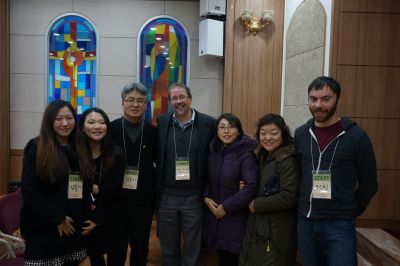Rhizome editorials
Emerging Anabaptism in Korea (Feb 2016)

On January 20-24, I visited South Korea for the first time, thanks to an invitation from Bock Ki Kim. Kim is director of the Korea Anabaptist Center and a key leader in the emerging Anabaptist movement there.
The official reason for the visit was to participate as a speaker in the first ever Korean Anabaptist Conference, an ecumenical gathering of scholars, pastors and laypeople organized by Kim and others as an effort “to introduce Anabaptist theology and values in a public, academic setting” and to “challenge ourselves as Korean Anabaptists to see who we are and what we have to do in South Korea.”
But there were lots of other things happening in the Korean Anabaptist movement as well. Jesus Village Church, one of the oldest Anabaptist-related congregations in South Korea and a key promoter of the Korea Anabaptist Center, had just celebrated its 20th anniversary as a congregation.
The Dae Jang Gan Press, which has overseen the translation and publication of scores of Anabaptist-Mennonite books, hosted a book launch for the Korean translation of my book Beliefs: Mennonite Faith and Practice. A group of diverse Mennonite, Baptist, Presbyterian and nondenominational leaders gathered for tea to discuss the future of the Anabaptist movement.
And on Sunday, January 24, the Jesus Village Church in Chuncheon celebrated World Fellowship Sunday, a day set aside for member groups of Mennonite World Conference to commemorate the beginnings of the Anabaptist movement in Switzerland 491 years ago.
Considered as a percentage of the total Christian church in Korea, the number of Korean Anabaptists today is quite modest. Nonetheless, the events in January symbolized a significant moment in a remarkable renewal movement that has been gaining momentum over the past two decades.
Today, South Korea is home to one of the most creative and dynamic expressions of contemporary Anabaptism anywhere in the global church, with potential for explosive growth in the future.
Not surprisingly, the emerging Anabaptist movement in Korea—like its counterpart in the sixteenth century—is far from unified. Some newcomers to the movement, for example, equate Anabaptism with community of goods. Others are looking for an egalitarian approach to church leadership, or a simple lifestyle, or a “small church” ecclesiology, or simply a canvas on which to imagine the possibility of “something different.”
One very conservative Baptist group recently translated selected portions of the Martyrs Mirror into Korean, leaving out sections that did not fit their theology. Even those congregations who have explicitly identified themselves as “Mennonites” are sorting through basic questions of ordination, child nurture, organizational structure, and polity.
Amid all these the creative and diverse currents, the future of the Anabaptist movement in Korea ultimately depends on the emergence of leaders—theologians, ethicists, historians, pastors and teachers—who will consciously continue the work of “indigenizing” Anabaptism. Clearly, the movement possesses individuals with the energy, training, commitment, and spiritual gifts needed to translate Anabaptism more fully into the Korean context.
Someday, I hope, the Institute for the Study of Global Anabaptism will face the challenge of translating texts from the leaders in the Korean Anabaptist movement into English for the edification of the church here. May that day come very soon!
–By ISGA Director John D. Roth. Originally appeared in the February 2016 issue of Rhizome.




